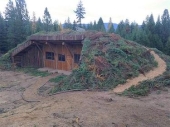Tyler Flaumitsch wrote:I was under the impression that you were going to point the gable end of the structure south to be able to replicate the terraced idea out the larger front and to see what the solar gain would be.
Wofati is aligned with the hill.
Passive solar structures are aligned with the sun.
This will be an attempt to demonstrate the power of annualized thermal inertia. So we are specifically NOT aligning this with the sun. I suppose that some folks will select building spots so they can have both. But for the first one, we had the discussion and I decided that I needed to find out the power of ATI without any additional help from the sun.
How do you plan on measuring performance?
I think we need to build some experience before we can measure performance.
For this first year: we are moving the dirt/soil during very cold temperatures. So the whole structure will start cold. I'm not sure how valuable the information will be from the first year.











